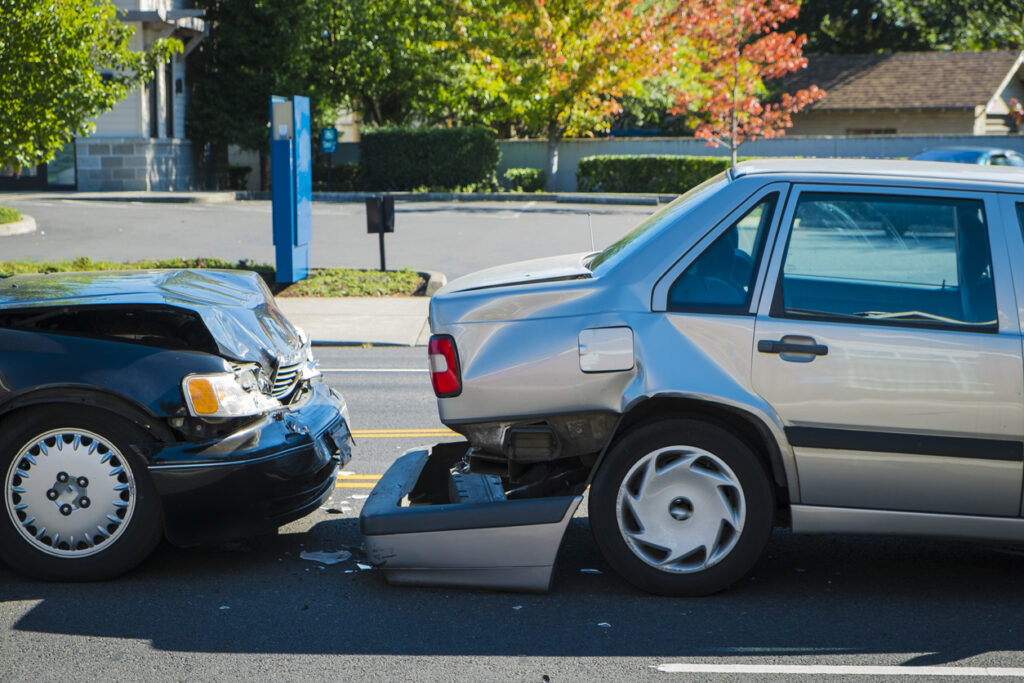Rear-End Collision Injuries and How You Can Recover

Rear-end collisions are some of the most common types of car accidents. They can result in a wide range of injuries, including severe injuries that lead to substantial medical bills or loss of earning ability. While rear-end accidents may seem less serious than high-speed crashes, they can still cause significant harm to drivers, passengers, and pedestrians.
Understanding the types of rear-end accident injuries that can occur and the typical recovery process is essential to obtaining the compensation you need after a crash.
Hurt? Need a Lawyer? Hire Murray
Give us a call for a FREE & CONFIDENTIAL Case Review
Common Types of Rear-End Accident Injuries
Rear-end accidents can produce multiple types of injuries. These can range from minor cuts and bruises to life-altering catastrophic injuries. While some rear-end crashes occur at lower speeds, even a minor accident can have a big impact on delicate body parts like the spine and brain.
Additionally, it’s not uncommon for rear-end crashes to occur on highways where vehicles are traveling at high speeds. In cases like this, a rear-end crash is more likely to lead to a life-threatening situation, like a rollover accident. Seeking prompt medical attention and following recommended treatments is crucial for recovery.
Whiplash
Whiplash is a common rear-end accident injury. This injury happens when the head and neck suddenly snap back and forth. It often occurs when a driver slams on the brakes or when a vehicle comes to a sudden halt after hitting another car or object.
Symptoms of a whiplash injury include:
- Neck pain
- Shoulder pain
- Neck stiffness
- Dizziness
- Headaches
- Reduced mobility
Whiplash injuries aren’t usually life-threatening. However, they can lead to severe chronic pain, ongoing medical treatment, and the need for physical therapy. In some cases, whiplash can result in severe spinal injuries that require surgery.
Spinal Cord Injuries
Whiplash might be the best-known spinal injury associated with rear-end crashes, but it’s not the only one. A rear-end accident puts your entire spine at risk of injury.
Some of the other spinal injuries that can occur during a rear-end collision include:
- Herniated discs
- Spinal fractures
- Muscle strain
- Nerve compression
- Spinal cord compression
These injuries can lead to chronic pain, limited mobility, and, in some cases, long-term disability. Prompt medical treatment is essential for recovery. When a spinal injury is severe, it can lead to lasting consequences like paralysis.
Brain Injuries
Rear-end accidents can cause brain injuries when the head is jerked backward and forward. Brain injuries might occur due to the head slamming against either the windshield or the headrest. However, a very sudden and strong motion can cause the brain to slam against the inside of the skull, leading to a brain injury.
Some of the most common types of brain injuries that happen during rear-end collisions include concussions, contusions, and traumatic brain injuries (TBIs). Symptoms range from mild to severe, but any injury to the brain requires immediate medical attention. Severe brain injuries often permanently impact the injured person’s cognitive abilities.
Other Common Injuries
Many other types of injuries frequently result from rear-end accidents.
Some of the most common include:
- Cuts and bruises
- Bone fractures
- Burns
- Strained muscles
- Seat belt injuries
- Depression, anxiety, or PTSD
As with the other common types of rear-end crash injuries, there’s no clear timeline for how an injured person’s long-term health will be affected. Some injuries might be minor, while others can be severe or cause long-term complications.
Dallas Lyft Accident Lawyer? Hire Murray
Give us a call for a FREE & CONFIDENTIAL Case Review
Recovering From Rear-End Accident Injuries
Recovering from rear-end accident injuries can be challenging. These accidents often cause a range of health problems. As a result, there’s no set treatment process or recovery time frame that applies to everyone injured in a rear-end crash.
All rear-end accident injuries, even minor ones, merit immediate medical attention. Seeing a doctor promptly and carefully following their instructions is the best way to support a speedy recovery. It might seem unnecessary to further interrupt your day by seeing a healthcare provider for minor injuries. However, a doctor might identify injuries you haven’t yet noticed.
The symptoms of some serious car accident injuries, such as organ damage, might not appear immediately. In many cases, the shock of the crash can result in the injured person failing to notice that something isn’t right.
Your physical health isn’t the only aspect you need to consider after a crash, either. If you need to pursue car accident compensation, whether you saw a doctor or not can have a direct bearing on your case.
Visiting a doctor helps establish documentation that the rear-end accident was the source of your injuries. It’s also important to carefully follow a doctor’s treatment instructions. Brushing off injuries or ignoring medical advice gives an insurance company grounds to claim that your actions make you partially responsible for your injuries.
Steps For Helping Your Rear-End Accident Injury Case
The steps you take in the immediate aftermath of the accident can directly impact the compensation you’re eligible to recover.
Essential steps to take after a crash include:
- File a police report
- Don’t apologize or admit fault
- Get contact information for any eyewitnesses
- Don’t post about the accident on social media
- See a doctor as soon as possible
- Follow all medical instructions
- Consult a car accident lawyer before speaking with an insurance company
The best way to protect yourself financially after a crash is to consult a rear-end accident attorney. A lawyer will advise you on how to move forward with successfully filing a claim. If you hire a lawyer for your case, they’ll handle tasks like communicating with the insurance company while you focus on your recovery.
Protect Yourself After a Rear-End Crash
Even a minor rear-end collision can significantly impact your physical and financial well-being. Rear-end collisions can lead to a variety of injuries, and the recovery process is not always straightforward. Understanding the types of injuries that can occur and the steps to take for recovery is essential.
The best way to protect yourself is to seek medical attention and consult a lawyer for legal advice about recovering compensation.
Contact Our Car Accident Law Firm in Dallas, TX
If you’ve been injured in an accident in Dallas, Texas, and need legal help, contact our Dallas car accident lawyers at Jay Murray Car Accident and Truck Accident Lawyers to schedule a free consultation today.
Jay Murray Car Accident and Truck Accident Lawyers
2512 State St,
Dallas, TX 75201
(214) 855-1420
